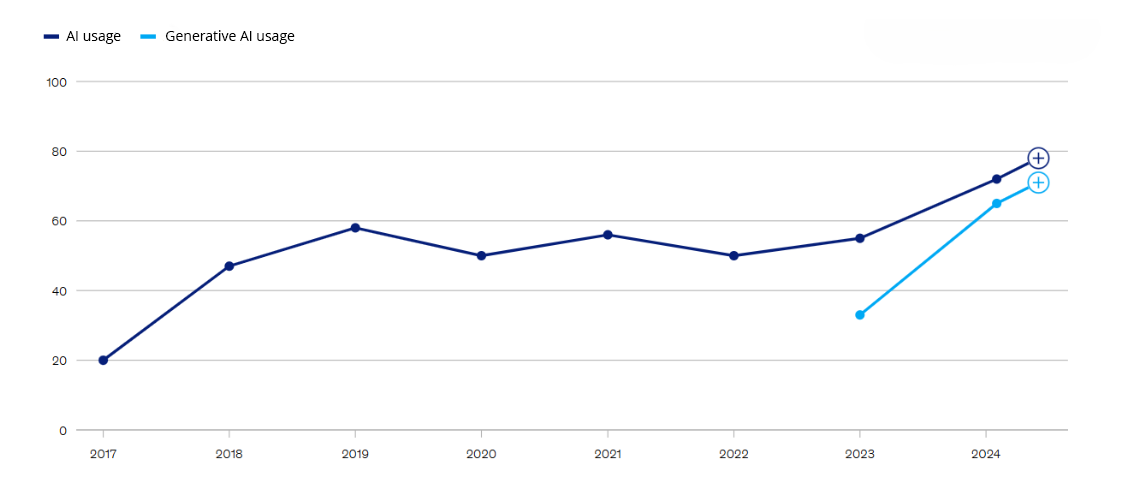AI for developers: tools, use cases and real productivity gains
In recent years, artificial intelligence has shifted from a futuristic promise to an essential ally in the day-to-day work of development teams. AI for developers, such as code assistants, automated bug analysis, and intelligent test generation, are transforming the way we write software.
Reducing repetitive tasks, accelerating delivery, and freeing developers to focus on what really matters, using technology to solve business problems.
According to the report The Economic Potential of Generative AI by McKinsey (2023) by McKinsey (2023), the use of generative AI in software development can reduce time spent on activities like coding, reviewing, and debugging by up to 45%.
That’s a significant productivity leap, especially in roles like software engineering, where those tasks take up a large part of the daily routine.
PwC (PricewaterhouseCoopers) also highlights a notable trend: industries with higher AI exposure have seen productivity growth nearly five times greater.

In 2017, the definition of AI adoption was using AI in a core part of the organization’s business or at scale.
In 2018–2019, it was defined as integrating at least one AI capability into business processes or products.
Since 2020, adoption has been defined as the organization using AI in at least one function.
Source: McKinsey Global Surveys on the State of AI.
As shown in the McKinsey chart (The State of AI: How Organizations Are Rewiring to Capture Value), their most recent 2024 research revealed that 78% of respondents say their organizations use AI in at least one business function, up from 72% earlier in 2024 and 55% the year before.
The business function that saw the biggest increase in AI adoption in the past six months was IT, where usage jumped from 27% to 36%.
These data reinforce the idea that AI not only complements developer skills, but also redefines software development practices — making processes more agile and efficient.
The tools that are changing the game
The evolution of AI is redefining the way we create software.
Today, a new generation of smart tools is emerging to support developers in complex tasks, streamline workflows, and improve overall team efficiency.
Below, we explore some of the solutions that are reshaping software development.

Amazon Q as a coding assistant
Code generation
AI-powered code generation tools are speeding up development, improving delivery quality, reducing production errors, simplifying test creation, and shortening the software build cycle.
Here are some of the standouts:
1. Amazon Q
Integrated with AWS services, Amazon Q allows natural language commands to generate APIs, databases, and complete instructions.
Want to know why your EC2 is slow? It can tell you. Want it to write code? Just prompt:
“Create a REST API using Lambda and API Gateway. Store the data in a DynamoDB table.” Amazon Q will return the Lambda function code, the table structure, and the steps to connect it to the API Gateway.
According to AWS, Amazon Q saved developers over 450,000 hours in 2024 alone.
2. GitHub Copilot
Considered your coding partner inside the IDE, Copilot was developed by GitHub with OpenAI and suggests code snippets in real time.
A GitHub research study (Quantifying GitHub Copilot’s Impact on Developer Productivity and Happiness) shows that developers using Copilot complete tasks up to 55.8% faster than those who don’t, with noticeable improvements in well-being, readability, and functionality.
3. Tabnine
Like Copilot, Tabnine is a code assistant powered by its own LLM trained on public and licensed codebases.
Unlike Copilot and Amazon Q, it can run fully offline and be highly customized, making it ideal for environments with strict data and code security requirements.
4. Sourcegraph Cody
In legacy or large codebases, understanding what’s already been built can be a real challenge.
Cody solves this with semantic search to extract context from both local and remote repositories, offering detailed explanations of APIs, flows, and patterns directly inside the editor.
While it doesn’t auto-generate code, it accelerates comprehension, enables better refactoring, and makes onboarding easier—especially with models like Claude 3.5 Sonnet and GPT-4o.
For more, see All You Need Is Cody (Sourcegraph, 2023).
Smarter testing
AI is also accelerating the validation stage in software development.
According to the ISG Provider Lens™ report, generative AI can increase productivity by 40% to 70% in specific tasks such as script creation and test execution. It also reduces execution time, expands test coverage, and identifies errors in real time.
Traditionally, writing an end-to-end (E2E) test can take anywhere from 30 minutes to several hours.
Tools like Testim promise to speed up that process with AI, enabling faster and more efficient creation and maintenance of tests. Here are three strong options:
1. Testim
Generates functional and E2E tests for web applications.
Tracks UI changes and reduces maintenance time by up to 80%. Its “Turbo” mode runs tests 25–30% faster than standard mode.
2. Diffblue
Specialized in Java, Diffblue automates unit test creation up to 250x faster from source code.
Companies like Goldman Sachs increased test coverage from 36% to 72% in less than 10% of the time it would take manually. Ideal for legacy system modernization.
3. CodeSquire
Tailored for Python and data science tasks, CodeSquire integrates with Jupyter and Colab notebooks to boost developer and data scientist productivity.
It suggests code snippets based on context, autocompletes functions, and offers detailed explanations, especially useful for analytics and machine learning projects.
Pain-Free documentation
Thanks to LLMs, documentation no longer has to be a chore.
Traditionally seen as bureaucratic and outdated, documentation often gets neglected under delivery pressure, but skipping it leads to real problems.
AI makes it easier to keep repositories clear and up to date. Developers can now maintain readable, maintainable code with much less effort.
Here are two tools that help:
1. Mintlify
Generates clean, up-to-date documentation pages automatically with every repository push. Perfect for agile teams that need reliable docs without spending time formatting them.
2. CodiumAI (Qodo)
Known for automated testing and logical error detection, CodiumAI also adds comments and docstrings directly in the code.
It integrates with VS Code and JetBrains and supports languages like Python, JavaScript, and TypeScript.
AI-Powered interfaces
In frontend development, much of the effort goes into translating visual ideas into working code. Mockups, prototypes, and last-minute changes can delay entire sprints.
AI helps bring ideas to life faster, with less rework.
1. Uizard
Turns sketches or images into interactive prototypes, helping teams skip the early-stage wireframing.
It also boosts collaboration between design, product, and development teams.
2. Builder.io
A visual platform with generative AI that writes and edits code with modern frameworks (React, Vue, Angular).
It allows non-technical team members to contribute, increasing productivity without sacrificing quality.
Both Uizard and Builder.io reduce rework by offering smart suggestions and even creating elements autonomously.
The future is now
AI for developers is no longer a trend, it’s the present. Tools like Amazon Q, Copilot, Tabnine, Uizard, and Builder.io are reshaping how developers work, for the better.
The question is no longer if we’ll use AI, but how to use it strategically to build smarter, faster, better solutions.
At e-Core, we believe in a future where human collaboration and technology fuel transformation. A future where human experience, efficiency, and innovation move in sync empowering developers and businesses to grow together through technology.
That’s why we embrace intelligent tools and cloud-based solutions to accelerate delivery, boost productivity, and add more value to our clients.

e-Core
We combine global expertise with emerging technologies to help companies like yours create innovative digital products, modernize technology platforms, and improve efficiency in digital operations.








